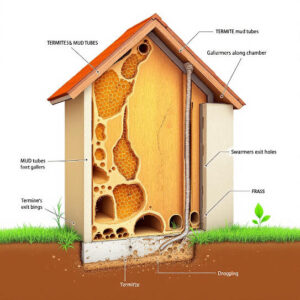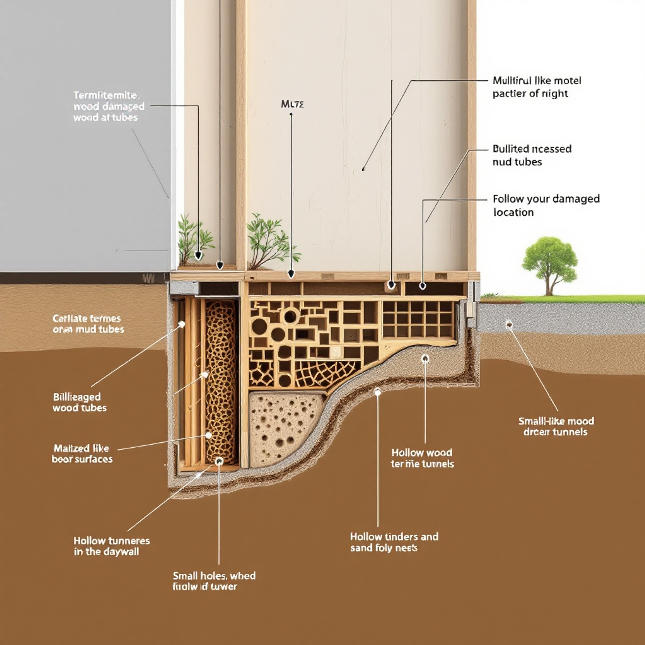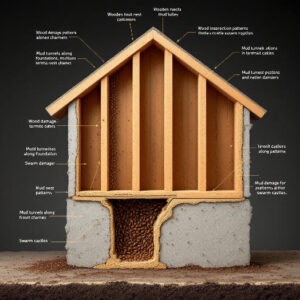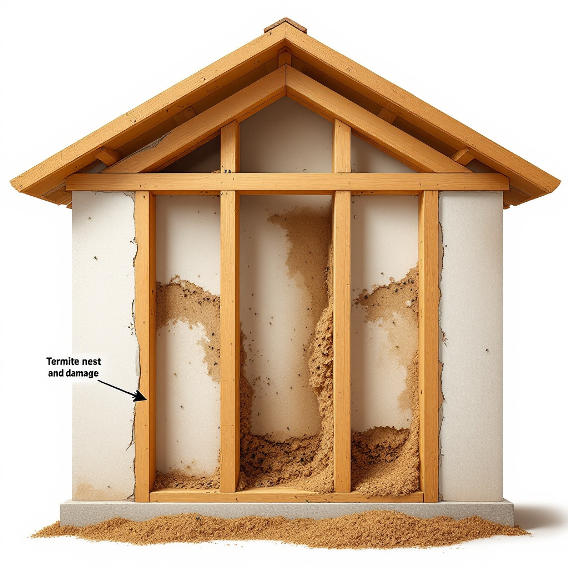Termites are a homeowner’s nightmare. These tiny pests can cause immense structural damage to your property if left unchecked. While termites can silently wreak havoc behind walls, early detection is crucial to preventing costly repairs and ensuring the safety of your home. But how do you know if termites have made themselves at home?What Are Termites and Why Are They a Threat?
Understanding Termite Biology and Behavior
Termites are small, soft-bodied insects that live in colonies. They primarily feed on cellulose, a component found in wood, paper, and other plant-based materials. A termite colony consists of workers, soldiers, and reproductive termites (swarmers). Each group has a specific role in maintaining the colony’s structure and survival.
Types of Termites Found in Homes
- Subterranean Termites
- These termites build their nests underground, often near moist soil. They travel through mud tubes to access your home’s wood and other cellulose-rich materials.
- Drywood Termites
- Unlike subterranean termites, drywood termites do not require soil contact. They infest dry wood, including furniture, beams, and flooring.
The Threat They Pose
Termites are often called “silent destroyers” because they can chew through wood, wallpaper, drywall, and even insulation without being noticed. Each year, termites cause billions of dollars in property damage worldwide. The problem is compounded by termite nests being often hidden, making early detection challenging. Ignoring the problem only allows infestations to grow, leading to more extensive and costly repairs.
Understanding Termite Nests: Where and How Do They Form?
What is a Termite Nest?
A termite nest is the central hub of the colony. It’s where termites breed, care for their young, and expand their colony. Nests can vary in location, size, and structure depending on the type of termite.
You may also read (are house flies really that big).
Types of Termite Nests
- Subterranean Termite Nests
- These nests are often located underground near moisture sources. Subterranean termites use mud tubes to travel from their nests to food sources, such as your home’s wooden structures.
- Drywood Termite Nests
- Drywood termites create nests within the wood they infest. These nests are much smaller than subterranean termite nests and can be found in furniture, walls, or wooden beams.
Common Nest Locations
- Inside the Home: In walls, ceilings, or wooden furniture.
- Around the Home: In soil near the foundation, tree stumps, or wooden debris.
- Moist Areas: Basements, crawl spaces, or anywhere with water leaks.
How Colonies Expand
Termites constantly build and expand their nests. This expansion allows them to invade new areas of your home, increasing the risk of significant structural damage.
Key Signs of a Termite Nest in Your House
If you’re wondering how to find a termite nest in your house, the first step is recognizing the signs of an infestation. Termites often leave clues that can help you pinpoint their presence.
Visible Signs
- Mud Tubes
- Subterranean termites build mud tubes to protect themselves as they travel from their nest to food sources. Look for these pencil-thin tubes along walls, foundations, or crawl spaces.
- Discarded Wings
- When reproductive termites (swarmers) leave the nest to establish new colonies, they shed their wings. You may find piles of these wings near windows, doors, or light sources.
- Termite Frass (Droppings)
- Drywood termites push out tiny pellets of wood-colored droppings, often mistaken for sawdust. These pellets are a clear sign of an infestation.
- Cracked or Distorted Paint
- Termites can cause paint on walls to bubble or crack due to the moisture they introduce.
- Hollow-Sounding Wood
- Tap wooden structures like beams or furniture. If it sounds hollow, termites may have eaten away the inside.
- Tiny Holes in Wood or Drywall
- As they burrow, termites often leave behind small, pin-sized holes in wood or walls.
- Sagging Floors or Ceilings
- Severe infestations can cause structural weakening, leading to sagging or uneven surfaces.
Less Obvious Signs
- Tight-Fitting Doors or Windows
- Warping caused by termite damage can make doors and windows difficult to open or close.
- Moldy or Mildew Smell
- Termites thrive in moist environments, and their nests can emit a musty odor.
- Unexplained Damage to Paper Products
- Termites often feed on books, cardboard, or wallpaper, leaving behind minor bite marks.
Step-by-Step Guide: How to Find Termite Nest in House
If you suspect termites, follow these steps to locate the nest and assess the severity of the infestation.
Inspect Common Entry Points
- Check foundations, basements, and crawl spaces for mud tubes or signs of termite activity.
- Inspect attics and roof timbers, as termites can enter through small cracks or gaps.
- Look around plumbing and utility lines, as termites often travel along these pathways.
Examine Wood Structures
- Tap wooden beams, floors, and furniture with a screwdriver. If they sound hollow, termites may have burrowed inside.
- Push a screwdriver gently into the suspect wood. If it sinks in easily, termites may have weakened the structure.
Look for Mud Tubes
- Focus on exterior walls, crawl spaces, and garage areas.
- Mud tubes are often brown and pencil-thin. Break one open to check for live termites.
Search for Frass and Discarded Wings
- Look for termite droppings near wooden structures, windows, or doors.
- Discarded wings are often found near light sources, as swarmers are attracted to light.
Use a Flashlight and Magnifying Glass
- Inspect dark corners, cracks, and crevices where termites might be hiding.
- A magnifying glass can help spot minor signs like frass or tiny holes.
Check for Swarmers
- Swarmers are most active in spring and summer. Keep an eye out for flying termites or their wings during these seasons.
Listen and Smell
- Put your ear to walls or wooden surfaces and listen for faint clicking or tapping sounds, which termites make as they chew.
- Pay attention to musty odors, which may indicate a nearby nest.
Tools and Techniques for DIY Termite Nest Detection
Basic Tools You’ll Need
- Screwdriver for probing wood.
- Flashlight for dark areas.
- Moisture meter to detect dampness caused by nests.
DIY Termite Detection Kits
- These kits can help identify termite activity but are not always accurate.
- They are best used as a supplement to visual inspections.
When to Use Professional Tools
- Advanced tools like thermal imaging cameras and acoustic sensors can detect hidden nests.
- If your DIY efforts are inconclusive, it’s time to call an expert.
Professional Inspection: When and Why to Call an Expert
Limitations of DIY Detection
While DIY methods can reveal obvious signs, termite infestations often extend far beyond what you can see. Professionals have the tools and expertise to identify hidden nests and assess the full extent of the damage.
What Professionals Do Differently
- Use specialized tools like thermal imaging and acoustic sensors.
- Conduct thorough inspections of all potential nesting sites, including inaccessible areas.
Choosing a Pest Control Company
Look for companies with:
- Licensed and certified technicians.
- Positive customer reviews.
- Transparent pricing and guarantees.
What to Do If You Find a Termite Nest
- Don’t Disturb the Nest
- Poking or prodding can cause termites to scatter, making the infestation harder to treat.
- Contact a Professional
- Termites require specialized treatment methods that DIY products cannot provide.
- Prevent Further Spread
- Seal cracks, remove excess moisture, and clear wood debris from your property.
Preventing Future Termite Infestations
- Schedule regular home inspections.
- Reduce moisture levels by fixing leaks and improving ventilation.
- Use termite-resistant materials for construction.
- Seal cracks in your home’s foundation and walls.
You may also read (why do midges appear in your house)

